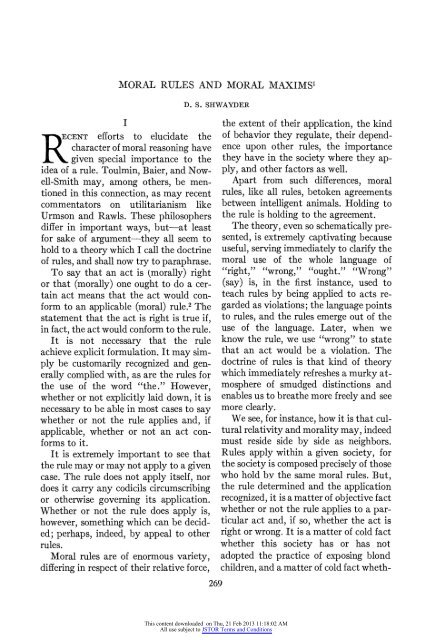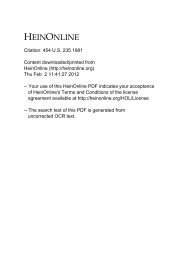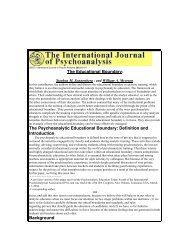MORAL RULES AND MORAL MAXIMS'D. S. SHWAYDERIRECENT efforts to elucid<strong>at</strong>e the~ character <strong>of</strong> moral reasoning havej\..given special importance to theidea <strong>of</strong> a rule. Toulmin, Baier, <strong>and</strong> Nowell-Smithmay, among others, be mentionedin this connection, as may recentcomment<strong>at</strong>ors on utilitarianism likeUrmson <strong>and</strong> Rawls. <strong>The</strong>se philosophersdiffer in important ways, but-<strong>at</strong> leastfor sake <strong>of</strong> argument-they all seem tohold to a theory which I call the doctrine<strong>of</strong> rules, <strong>and</strong> shall now try to paraphrase.To say th<strong>at</strong> an act is (morally) rightor th<strong>at</strong> (morally) one ought to do a certainact means th<strong>at</strong> the act would conformto an applicable (moral) rule.2 <strong>The</strong>st<strong>at</strong>ement th<strong>at</strong> the act is right is true if,in fact, the act would conform to the rule.It is not necessary th<strong>at</strong> the ruleachieve explicit formul<strong>at</strong>ion. It may simplybe customarily recognized <strong>and</strong> generallycomplied with, as are the rules forthe use <strong>of</strong> the word "the." However,whether or not explicitly laid down, it isnecessary to be able in most cases to saywhether or not the rule applies <strong>and</strong>, ifapplicable, whether or not an act conformsto it.It is extremely important to see th<strong>at</strong>the rule may or may not apply to a givencase. <strong>The</strong> rule does not apply itself, nordoes it carry any codicils circumscribingor otherwise governing its applic<strong>at</strong>ion.Whether or not the rule does apply is,however, something which can be decided;perhaps, indeed, by appeal to otherrules.<strong>Moral</strong> rules are <strong>of</strong> enormous variety,differing in respect <strong>of</strong> their rel<strong>at</strong>ive force,269the extent <strong>of</strong> their applic<strong>at</strong>ion, the kind<strong>of</strong> behavior they regul<strong>at</strong>e, their dependenceupon other rules, the importancethey have in the society where they apply,<strong>and</strong> other factors as well.Apart from such differences, moralrules, like all rules, betoken agreementsbetween intelligent animals. Holding tothe rule is holding to the agreement.<strong>The</strong> theory, even so schem<strong>at</strong>ically presented,is extremely captiv<strong>at</strong>ing becauseuseful, serving immedi<strong>at</strong>ely to clarify themoral use <strong>of</strong> the whole language <strong>of</strong>"right," "wrong," "ought." "Wrong"(say) is, in the first instance, used toteach rules by being applied to acts regardedas viol<strong>at</strong>ions; the language pointsto rules, <strong>and</strong> the rules emerge out <strong>of</strong> theuse <strong>of</strong> the language. L<strong>at</strong>er, when weknow the rule, we use "wrong" to st<strong>at</strong>eth<strong>at</strong> an act would be a viol<strong>at</strong>ion. <strong>The</strong>doctrine <strong>of</strong> rules is th<strong>at</strong> kind <strong>of</strong> theorywhich immedi<strong>at</strong>ely refreshes a murky <strong>at</strong>mosphere<strong>of</strong> smudged distinctions <strong>and</strong>enables us to bre<strong>at</strong>he more freely <strong>and</strong> seemore clearly.We see, for instance, how it is th<strong>at</strong> culturalrel<strong>at</strong>ivity <strong>and</strong> morality may, indeedmust reside side by side as neighbors.<strong>Rules</strong> apply within a given society, forthe society is composed precisely <strong>of</strong> thosewho hold bv the same moral rules. But,the rule determined <strong>and</strong> the applic<strong>at</strong>ionrecognized, it is a m<strong>at</strong>ter <strong>of</strong> objective factwhether or not the rule applies to a particularact <strong>and</strong>, if so, whether the act isright or wrong. It is a m<strong>at</strong>ter <strong>of</strong> cold factwhether this society has or has notadopted the practice <strong>of</strong> exposing blondchildren, <strong>and</strong> a m<strong>at</strong>ter <strong>of</strong> cold fact wheth-This content downloaded on Thu, 21 Feb 2013 11:18:02 AMAll use subject to JSTOR Terms <strong>and</strong> Conditions
270 ETHICSer this is a blond child; it is, therefore, am<strong>at</strong>ter <strong>of</strong> cold fact whether this childought to be exposed.This makes clear why morals must be"social." For agreements are agreementsbetween men, governing their mutualbehavior.<strong>The</strong> theory <strong>of</strong>fers us some hope <strong>of</strong> sayingwh<strong>at</strong> the r<strong>at</strong>ionale <strong>of</strong> a moral rule is,<strong>and</strong> this turns out to be something socialin a more delimited sense.<strong>The</strong> doctrine puts us in a position toappreci<strong>at</strong>e the importance <strong>of</strong> havingmoral rules <strong>and</strong> thereby clears the wayfor specifying criteria for resolving thevexed question <strong>of</strong> ascertaining the rel<strong>at</strong>ivemerits <strong>of</strong> different rules, <strong>and</strong> so providinga test for deciding whether <strong>and</strong>how we should modify such <strong>and</strong> suchpractices. We do this by exploiting thedistinction, as it is sometimes called,between legisl<strong>at</strong>or <strong>and</strong> judge; betweenthe promulg<strong>at</strong>ion or enactment <strong>of</strong> rules<strong>and</strong> the utilizing <strong>of</strong> the rules to appraisebehavior as right or wrong. We can now<strong>at</strong> last clearly appreci<strong>at</strong>e the complementarycharacter <strong>of</strong> teleological <strong>and</strong> deontologicalethics, <strong>and</strong> thus gain a renewed<strong>and</strong> less haphazard appreci<strong>at</strong>ion <strong>of</strong> each.Not the least advantage <strong>of</strong> this theory isth<strong>at</strong> it permits us with good conscience<strong>and</strong> little loss to allow "objective" <strong>and</strong>"subjective" to slide into the desuetudethey deserve; for we can now see in wh<strong>at</strong>manner compliance with rules is both"objective" <strong>and</strong> "subjective" <strong>and</strong> howuseless this way <strong>of</strong> putting it is.In short, we gain a fresh <strong>and</strong> broadview <strong>of</strong> nearly the whole <strong>of</strong> moral philosophy,seeing how the various keyproblems <strong>and</strong> concepts rel<strong>at</strong>e to one another;<strong>and</strong> the field once again appearsreasonable, even reasonably tidy.II<strong>The</strong> <strong>at</strong>mosphere does not, however, remainso clear <strong>and</strong> clean, for the doctrine<strong>of</strong> rules bears its own nascent obscuritieswhich grow large <strong>and</strong> soon loom allaround.A major advantage <strong>of</strong> the theory isth<strong>at</strong> it permits us to apply to problems<strong>of</strong> moral philosophy more general <strong>and</strong>readily grasped facts about the concept<strong>of</strong> a rule. But this advantage carries thecoll<strong>at</strong>eral responsibility <strong>of</strong> distinguishingclearly between moral rules <strong>and</strong> others.This is no easy task <strong>and</strong> perhaps an impossibleone.3We speak <strong>of</strong> rules in many differentconnections. We have club rules <strong>and</strong>rules for games; formal rules such asthose <strong>of</strong> arithmetic; religious <strong>and</strong> ceremonialrules; rules <strong>of</strong> etiquette <strong>and</strong> rulesfor parliamentary procedure, laws in thelegal sense <strong>and</strong> rules <strong>of</strong> language. Indeed,it would be a mistake to suppose th<strong>at</strong>these are all in themselves unified ideas,as Wittgenstein's illustr<strong>at</strong>ive examin<strong>at</strong>ions<strong>of</strong> "game" <strong>and</strong> the idea <strong>of</strong> language,<strong>and</strong> Hart's examin<strong>at</strong>ion <strong>of</strong> legal argument,show. But these different kinds <strong>of</strong>rule must all be distinguished from moralrules, if there be such.<strong>The</strong> <strong>at</strong>tempt to harden <strong>and</strong> elabor<strong>at</strong>ethe peculiar character <strong>of</strong> moral rules carriesin train a series <strong>of</strong> interconnectedembarrassments for the doctrine <strong>of</strong>rules. For, after saying th<strong>at</strong> moral rulesare not like rules <strong>of</strong> this <strong>and</strong> th<strong>at</strong> in these<strong>and</strong> those ways, there seems little left <strong>of</strong>the rule conception <strong>of</strong> morality.I shall now briefly adumbr<strong>at</strong>e some <strong>of</strong>the difficulties, without trying to settlethem, or even hoping th<strong>at</strong> I could, forthey give me abundant reason to thinkth<strong>at</strong> morality wants something otherthan the pure doctrine <strong>of</strong> rules.<strong>The</strong> first distinguishing fact aboutmoral rules is their vast sway in severaldirections. First, particular rules do nothold just for a certain segment <strong>of</strong> society;save for certain special exceptionswhichmust be exceptions-they hold forThis content downloaded on Thu, 21 Feb 2013 11:18:02 AMAll use subject to JSTOR Terms <strong>and</strong> Conditions
















